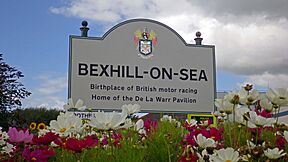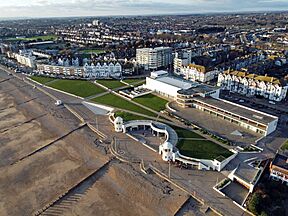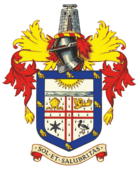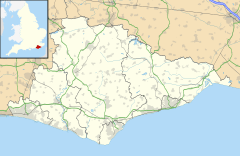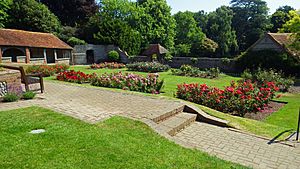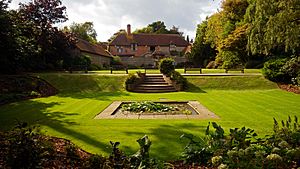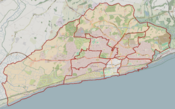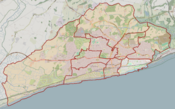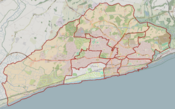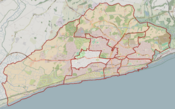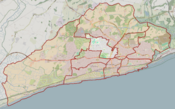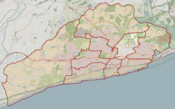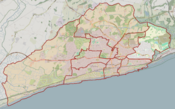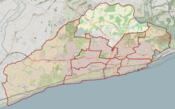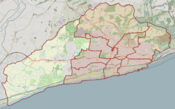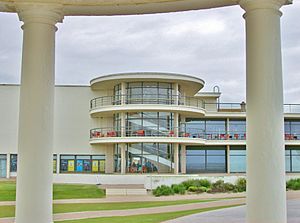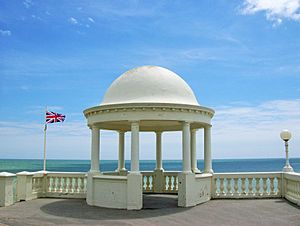Bexhill-on-Sea facts for kids
Quick facts for kids Bexhill-on-Sea
|
|
|---|---|
|
Clockwise from top: Town welcome sign; Combe Valley Countryside Park; De La Warr Pavilion and Central Parade; High Street, Old Town.
|
|
|
Official flag and coat of arms of Bexhill-on-Sea.
|
|
| Area | 32.31 km2 (12.47 sq mi) |
| Population | Expression error: "43,754 (2021)" must be numeric |
| OS grid reference | TQ737092 |
| • London | 52.7 miles (84.8 km) NNW |
| Civil parish |
|
| District |
|
| Shire county | |
| Region | |
| Country | England |
| Sovereign state | United Kingdom |
| Post town | BEXHILL-ON-SEA |
| Postcode district | TN39-40 |
| Dialling code | 01424 |
| Police | Sussex |
| Fire | East Sussex |
| Ambulance | South East Coast |
| EU Parliament | South East England |
| UK Parliament |
|
Bexhill-on-Sea (often called Bexhill) is a town by the sea in East Sussex, England. It is part of the Rother District. You can find it along the Sussex Coast, between the towns of Hastings and Eastbourne.
Contents
History of Bexhill
The first time Bexhill was mentioned was in 772 AD. It was called Bexelei back then. King Offa of Mercia gave a special paper, called a charter, about it. He had beaten the "men of Hastings" the year before. At that time, "Hastings" meant the whole area, not just the town we know today. King Offa set up a church and a religious group in Bexhill.
Early Days and Norman Conquest
When the Normans conquered England in 1066, Bexhill was mostly destroyed. Records from 1086 show that the area was "waste" after the conquest. King William I gave Bexhill to Robert, Count of Eu. Later, in 1148, Robert's grandson gave it to the bishops of Chichester. They probably built the first manor house then. The ruins of a later manor house, built around 1250, can still be seen in Bexhill Old Town. This house was used by the bishops when they travelled.
In 1561, Queen Elizabeth I took over Bexhill Manor. A few years later, she gave it to Sir Thomas Sackville. His family, the Earls (and later Dukes) of Dorset, owned Bexhill until the mid-1800s.
Soldiers and Smugglers
In 1804, soldiers from the King's German Legion stayed in Bexhill. These were German troops who had escaped Napoleon's French Army. They fought with the British Army. Around this time, strong towers called Martello Towers were built along the coast to stop a French invasion. The German soldiers left Bexhill in 1814. They later helped win the Battle of Waterloo.
Even though soldiers were there to protect Bexhill, many local people were involved in smuggling. They traded illegally with the enemy. One famous event was the Battle of Sidley Green in 1828, involving the Little Common Gang of smugglers.
Bexhill Becomes a Seaside Resort
In 1865, the 7th Earl De La Warr inherited Bexhill. He decided to turn the small village into a fancy seaside resort. He hired a builder, John Webb, to build the first sea wall and create De La Warr Parade.
The grand Sackville Hotel opened in 1890. It was built for the Earl. In 1891, his son, Viscount Cantelupe, married Muriel Brassey. They lived in the refurbished Manor House. When the 7th Earl died in 1896, Viscount Cantelupe became the 8th Earl De La Warr.
The 8th Earl built the Kursaal, a pavilion for entertainment, and a bicycle track on the seafront. These things helped make Bexhill a popular new resort. Many private schools also moved to the town because it was known for being healthy.
The Railway and Motor Racing
The railway reached Bexhill in 1846. The first station was small and far from the village. A new station opened in 1891, closer to the growing resort. The current main station opened in 1902. Another station, Bexhill West, was built for a new railway line.
In 1902, Bexhill became an official Borough. This was the first Royal Charter given by King Edward VII. It was also the first time a Royal Charter was delivered by car! To celebrate, the 8th Earl De La Warr held the country's first ever motorcar races along De La Warr Parade in May 1902.
World War II and After
During the Second World War, many schools in Bexhill had to close or move. The town also suffered some bomb damage. After the war, some schools returned, but over time, fewer independent schools stayed. This was partly because the British Empire ended, and many children of families overseas no longer came to Bexhill for school. However, many former students and their parents loved Bexhill and later retired there.
How Bexhill is Governed
Since 1974, Bexhill has been part of Rother District Council. This means it lost its own Town Council for a while. Instead, Bexhill had "Charter Trustees," who were the Bexhill councillors on the Rother District Council. They held meetings to let the community share their ideas.
The Bexhill Town Hall is where the Rother District Council meets. Elections for this council happen every four years. Out of 38 councillors for Rother, 18 come from Bexhill.
Bringing Back a Town Council
In 2017, people in Bexhill wanted their own Town Council back. Over 9,000 people took part in a survey, and most of them (93.5%) said yes. However, the Rother District Councillors voted against it. They were worried about the extra cost for local taxpayers. But on April 1, 2021, a new local council, called a civil parish, was finally formed for Bexhill.
Other Levels of Government
Above Rother District Council is the East Sussex County Council. They are in charge of things like schools, libraries, roads, and social services. Elections for the County Council also happen every four years. Bexhill is split into four areas for these elections.
Bexhill is also part of a larger area called the Bexhill and Battle Parliamentary Constituency. This area includes the nearby town of Battle. The person who represents this area in the UK Parliament is called the Member of Parliament (MP). The current MP is Kieran Mullan.
Local Areas (Wards)
Bexhill is divided into smaller areas called wards. Each ward has its own councillors who represent the people living there. Here are the wards and their populations:
Famous Landmarks
The most famous building in Bexhill-on-Sea is the De La Warr Pavilion. It is a very important building, located right on the seafront. The 9th Earl De La Warr, who was also the Mayor of Bexhill, wanted a public building here.
Design and Construction
A competition was held in 1934 to design the building. Architects were asked for an entertainment hall, a restaurant, a reading room, and a lounge. The budget was about £80,000. Over 230 designs were submitted.
The winning architects were Erich Mendelsohn and Serge Chermayeff. They were leaders in the Modern Movement, a style of architecture. This style uses clean lines, industrial designs, and lots of glass. It often uses concrete and steel instead of traditional bricks. The building was one of the first major Modernist public buildings in Britain. Construction started in January 1935.
The Duke and Duchess of York (who later became King George VI and Queen Elizabeth) opened the building on December 12, 1935.
The Pavilion Through the Years
During World War II, the De La Warr Pavilion was used by the military. Bexhill was a likely target if Germany invaded. Even the famous comedian Spike Milligan served at the Pavilion during the war. The building had minor damage when a nearby hotel was bombed.
After the war, the local council took over the Pavilion. Some changes were made that didn't fit the original design. Also, there wasn't enough money to keep the building in good shape.
In 1986, the De La Warr Pavilion was given a special status to protect it. A group called the Pavilion Trust was formed in 1989 to help save and restore the building. In 2002, they received £6 million to restore it and turn it into a modern arts centre. The building reopened in 2005. Today, it has one of the largest art galleries on the south coast.
Other Interesting Places

- High Woods is a special area of woodland in Bexhill. It's important because it's the only place in East Sussex with a certain type of oak tree.
- Fossils are often found in Bexhill. In 2009, the world's oldest spider web, 140 million years old, was found here. In 2011, the world's smallest dinosaur fossil (just one bone) was discovered near the town.
- The wreck of the VOC Amsterdam is an old cargo ship from the 1700s. It ran aground between Bexhill and St Leonards. You can sometimes see its remains at low tide.
Economy and Life in Bexhill
Reginald Sackville, the seventh Earl De La Warr, was key in changing Bexhill from a small village into a popular seaside resort. He built the sea wall and De La Warr Parade. Large houses were then built nearby, and the new town began to grow.
The luxurious Sackville Hotel was built in 1890.
Birthplace of British Motor Racing
Bexhill is famous for holding the first ever motor race in the United Kingdom. This happened in May 1902. Signs at the edge of town proudly say "Birthplace of British Motor Racing." There used to be a big festival called the Bexhill 100 Festival of Motoring. It celebrated this history until 2002. Now, the Bexhill 100 Motoring Club still holds a Classic Car Show every August.
The De La Warr Pavilion, which opened in 1935, is a great example of modern architecture. It is a major public building in Britain.
Bexhill Today
Like many other seaside towns in England, Bexhill is now a settled community. It has a small entertainment area by the sea. Many retired people live here, similar to other towns on the south coast.
Efforts are being made to bring more tourists to Bexhill. Events like the 'Festival of the Sea' are held every year.
Getting Around Bexhill
Bexhill is on the A259 road, which runs along the coast. A new road was built in 2016 to help with traffic.
The town has three railway stations: Cooden Beach, Collington, and Bexhill. You can catch trains to places like Ashford, Brighton, and London Victoria.
Bexhill also has many bus routes. These buses connect Bexhill to nearby areas like Hastings, Battle, and Eastbourne.
The first railway line came to Bexhill in 1846. The current main station was built in 1891. Another railway line, from Crowhurst, opened in 1902 but closed in 1964.
Sports and Fun
Bexhill has three local football clubs: Bexhill United F.C., Little Common F.C., and Sidley United F.C..
Bexhill also shares a Rugby Union club with Hastings. It's called Hasting and Bexhill Rugby Football Club.
The Bexhill Amateur Athletic Community Association is a sports club on Little Common Road. It has football, Judo, fitness classes, and a gym.
The Little Common Ramblers Cricket Club plays at the Recreation Ground. They have three adult teams. In 2018, their top team was promoted to the Sussex County League for the first time.
Rother Swim Academy in Bexhill-on-Sea offers swimming lessons for children. It was started in 1990 and is run by a family.
Marina Court Garden opened in 2015. It has a special coin collector from the Bexhill Rotary Club. The money collected helps local charities.
Culture in Bexhill
In 2013, a survey found that 68% of people in the Rother area (where Bexhill is) were "proud to be English." This was higher than the national average.
Bexhill holds a world record for the most mermaids in one place (325). This happened in September 2017 at the annual 'Festival of the Sea'. The town also used to hold the record for the largest Charleston dance, as part of its 'Bexhill Roaring 20s' festival.
Climate
Bexhill has a maritime climate. This means it has cool summers and mild winters. It is also on the eastern edge of one of the sunniest parts of the UK coast.
| Climate data for Hastings 1981–2010, extremes 1960– | |||||||||||||
|---|---|---|---|---|---|---|---|---|---|---|---|---|---|
| Month | Jan | Feb | Mar | Apr | May | Jun | Jul | Aug | Sep | Oct | Nov | Dec | Year |
| Record high °C (°F) | 15.0 (59.0) |
14.0 (57.2) |
19.0 (66.2) |
24.4 (75.9) |
26.1 (79.0) |
32.3 (90.1) |
33.2 (91.8) |
31.5 (88.7) |
27.2 (81.0) |
22.2 (72.0) |
17.2 (63.0) |
14.5 (58.1) |
33.2 (91.8) |
| Mean daily maximum °C (°F) | 7.7 (45.9) |
7.6 (45.7) |
9.9 (49.8) |
12.6 (54.7) |
15.9 (60.6) |
18.5 (65.3) |
20.7 (69.3) |
21.0 (69.8) |
18.7 (65.7) |
15.2 (59.4) |
11.3 (52.3) |
8.4 (47.1) |
14.0 (57.1) |
| Mean daily minimum °C (°F) | 3.1 (37.6) |
2.7 (36.9) |
4.2 (39.6) |
5.9 (42.6) |
9.1 (48.4) |
11.7 (53.1) |
14.0 (57.2) |
14.2 (57.6) |
12.3 (54.1) |
9.6 (49.3) |
6.1 (43.0) |
3.8 (38.8) |
8.1 (46.5) |
| Record low °C (°F) | −9.8 (14.4) |
−8.8 (16.2) |
−6.1 (21.0) |
−2.1 (28.2) |
0.0 (32.0) |
2.8 (37.0) |
6.7 (44.1) |
7.4 (45.3) |
4.4 (39.9) |
0.2 (32.4) |
−5.6 (21.9) |
−6.7 (19.9) |
−9.8 (14.4) |
| Average precipitation mm (inches) | 75 (3.0) |
52 (2.0) |
53 (2.1) |
48 (1.9) |
48 (1.9) |
50 (2.0) |
49 (1.9) |
52 (2.0) |
60 (2.4) |
96 (3.8) |
87 (3.4) |
61 (2.4) |
731 (28.8) |
| Mean monthly sunshine hours | 72 | 90 | 127 | 196 | 230 | 232 | 247 | 235 | 168 | 128 | 85 | 61 | 1,871 |
| Source 1: Royal Dutch Meteorological Institute | |||||||||||||
| Source 2: Met Office [1] | |||||||||||||
Notable People from Bexhill
Many interesting people have lived in or are connected to Bexhill:
- Hertha Marks Ayrton: An engineer and physicist who studied electricity and ripples.
- John Logie Baird: The Scottish inventor of television, lived here later in his life.
- James Beeching: A shipbuilder who invented a self-righting lifeboat.
- Joyce Lankester Brisley: Wrote the popular Milly-Molly-Mandy stories.
- Michael Cowpland: Founder of big tech companies like Mitel and Corel.
- Fanny Cradock and Johnnie Cradock: Famous TV chefs.
- Max Faulkner: A professional golfer who won the Open championship in 1951.
- Norman Franks: An aviation historian who wrote many books about military planes.
- Ruth Gipps: A composer and music organiser.
- Jimmy Glover: An Irish composer and conductor, who was Mayor of Bexhill in 1906–07.
- Sir David Hare: A well-known British writer for plays.
- Peter Katin: A concert pianist.
- Sir Philip Ledger: A classical musician and composer, born in Bexhill.
- Desmond Llewelyn: The actor who played Q in the James Bond films, lived here until he died.
- Ted Lowe: A snooker commentator for the BBC.
- Kate Marsden: A nurse who travelled through Siberia helping people with leprosy. She also helped start the Bexhill Museum.
- Spike Milligan: A famous comedian who was stationed in Bexhill during World War II.
- Hayley Okines: A young patient with a rare aging disease called progeria.
- Andrew Sachs: An actor who had his first stage performance at the De La Warr Pavilion.
- Alex Saunders: The founder of Alexandrian Witchcraft.
- Ronald Skirth: A conscientious objector and author of a First World War memoir.
- Eric Slater: An English artist known for his prints of the countryside.
- Gwyneth Strong: The actress who played Cassandra in Only Fools and Horses lives in Bexhill.
- Oli Thompson: A strongman who won Britain's Strongest Man in 2006.
- Angus Wilson: A novelist and campaigner for equality, born in Bexhill.
- Jimmy Robertson: A professional snooker player, born in Bexhill.
Freedom of the Town
Some people and military groups have been given the special "Freedom of the Town" of Bexhill-on-Sea. This is a great honour.
Individuals
- Thomas Brassey, 1st Earl Brassey: 9 November 1911.
- John Alexander Paton: 29 March 1920.
- William Nicholson Cuthbert: 25 January 1943.
- Christine Isabella Meads: 5 March 1952.
- Ernest William Bowrey: 5 March 1952.
- Richard Cecil Sewell: 5 March 1952.
- Frances Burrows: 29 January 1958.
- Claude Pycroft: 27 September 1962.
- Joyce Alexander: 2 October 1968.
- Harry Riley: 2 October 1968.
- Ian Allen: 29 July 2009.
- Matthew Hellier: 29 July 2009.
- Nick McCorry: 29 July 2009.
- Phil McCorry: 29 July 2009.
- Stuart Earl: 13 October 2019.
See also
 In Spanish: Bexhill-on-Sea para niños
In Spanish: Bexhill-on-Sea para niños


